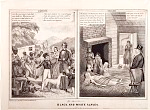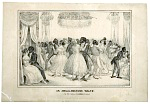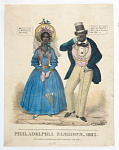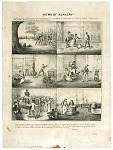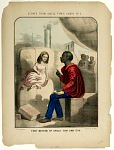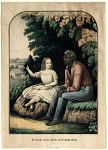Donnelly, A Clay, Edward Williams
Description
This lithograph, designed by Edward William Clay, a Northern apologist for slavery, contrasts an idealized scene of seemingly content slaves in America with that of a family of forlorn factory workers in England. In the left “America” panel, a well-dressed slave-holder is depicted with his wife, children, and greyhound. The plantation-owner’s son gestures towards two elderly slaves, who thank their master for providing for them. The white man, in turn, responds that as a long as “a dollar is left me, nothing shall be spared to increase their comfort and happiness.” In the background, a group of slaves is shown smiling and dancing to fiddle music. The circumstances of the black slaves were meant to be interpreted as more favorable than the conditions of life for “white slaves” in England, depicted in the right panel. Here, a starving, unemployed factory worker sits with his malnourished, sickly family, as a man in a top hat instructs him to enter a workhouse.Edward Williams Clay was born in Philadelphia in 1799. He originally found employment as an attorney and became a member of the Philadelphia Bar Association in 1825, but he later abandoned law for a career in art. He moved to New York City in 1837 but shortly after was forced to end his artistic career when his eyesight began to fail. The publisher of the work, Arthur Donnelly, maintained a shop at 19 ½ Courtland Street, New York.Currently not on view
Ink (Overall Material)Paper (Overall Material)
Harry T. Peters "America on Stone" Lithography Collection
